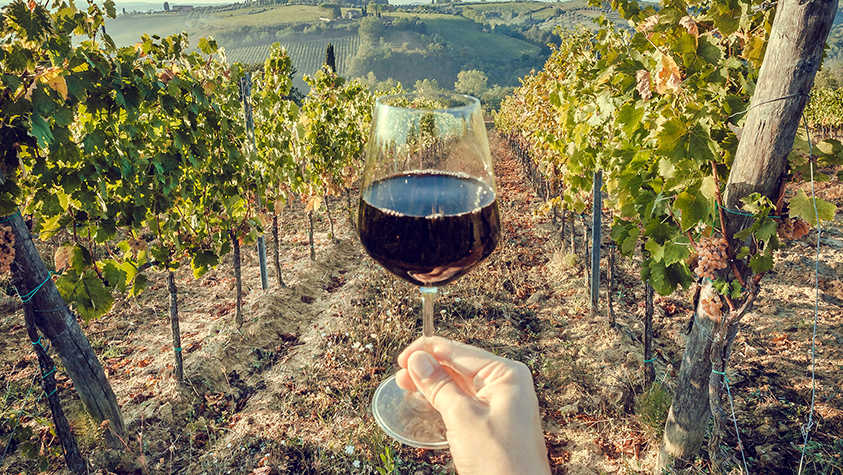Is there poison in your glass?
Now that I’ve got your attention, let me rephrase that. If you, like so many of us, want to know where your food comes from—ideally, a local organic farmer or rancher at your farmer’s market, or from the organic section of your supermarket—do you extend the same due diligence to a glass of wine? (Or, for that matter, a beer or cocktail?)
In other words, are there health hazards (beyond the obvious overindulgence) to drinking the equivalent of factory-farmed wine and other alcohol?
The subject is complex, so for this discussion, let’s stick to wine. Nonorganic wines are made from grapes often sprayed with pesticides, herbicides, fungicides and insecticides, and treated with chemical fertilizers. Government agencies that are lobbied heavily by chemical companies and conventional farming organizations will tell you that these substances are perfectly safe when used as directed.
Organic wines—and those labeled “Made with organic grapes”—can be made using specific remedies to combat insects, leaf mold and other vineyard challenges, but most of these are naturally derived, not created by chemists. Biodynamic wines, too, are grown without chemicals and GMOs, with added practices to nurture the soil and surrounding environment.
We are reminded of Rule No. 19 in author and activist Michael Pollan’s Food Rules: “If it’s a plant, eat it. If it was made in a plant, don’t.”
The Hidden Additives
Then there is the matter of additives. Pollan also got us reading food labels—and rejecting those with ingredients that our great-grandmothers wouldn’t know. Wine is food of the gods, so the saying goes, but alcohol products, in general, have so far successfully resisted passage of laws requiring such labeling. In Wine Food: New Adventures in Drinking and Cooking, sommelier Dana Frank and Andrea Slonecker, note, “There’s a laundry list of legally approved additives that can be used in wine-making—everything from colorants to tannin softeners, to fish bladders.”
Others commonly used include: egg white, milk products, gelatin, and substances derived from pig and cow pancreas and stomach (vegans, take note).
Organic wines can use these substances for fining (clarifying) and filtering, too. But the one additive that sets organic wines apart is sulfur in the form of sulfites (sulfur dioxide), a preservative that keeps wine from turning brownish. A small percentage of us is allergic to sulfites, which can produce asthma-like symptoms (not headaches, a common misconception). U.S. law requires wine labels to state “contains sulfites” if a wine contains 10 or more parts per million (ppm) of this substance, which is naturally occurring in small quantities in wine. Organic wine cannot contain more than this. Conventional wine can contain up to 350 ppm, and sulfites are added routinely to extend freshness and shelf life, especially in white, rose and sweet wines. Some research suggests hangover symptoms may be linked to high levels of sulfites.
Skip the Roundup
But one of the most concerning aspects of vineyard management these days has nothing to do with anything applied directly to the grapes. It’s a chemical used to kill weeds that border the vines—glyphosate, better known as Roundup. Trace amounts of the widely used herbicide made infamous by Monsanto (recently bought by Bayer AG) were found in 19 of 20 wines and beers recently tested by U.S. Public Research Group (USPIRG).
According to the USPIRG report, St. Helena, California-based Sutter Home wine, a convenience store staple, had the highest levels of glyphosate, at 51 parts per billion (ppb). Glyphosate is banned in organic farming, so that should be the end of that story. Yet it was detected in several organic wines tested, including Inkarri Estate and Frey Organic Natural White wines. How the chemical herbicide got in the organic soil is unknown—wind drift from nearby nonorganic fields, perhaps? If there’s a shred of good news there, it’s that, at 5.2 ppb and 4.8 ppb, respectively, levels were significantly lower than in conventional labels.
A Safer Way
In his book, Spontaneous Healing, Dr. Andrew Weil compares the human body to a river. In a healthy river, pollutants, debris and sludge are sluiced away—until too much of the bad stuff overwhelms its ability to “heal.” Today’s world is awash in unhealthy inputs, such as the dirty air we breathe, the chemical-laden food and water we consume, plastics and other petrochemical products that surround us, UV rays and maybe even unseen EMFs. Why add more with wine, potentially, when it can be—has been for centuries—made for our enjoyment in a more natural, safer way?
And, oh, by the way, just because a wine is labeled organic (or “grown with organic grapes,” biodynamic or sustainably farmed) doesn’t mean you’ll love it. You’ll still have to channel your inner Michael Pollan and read the label, be selective and find the bottles that suit your palate, occasion and food.
Don’t forget to recycle the bottle. Why not help the planet while you toast your health?




